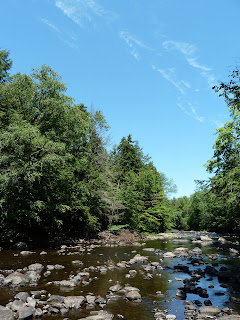Some random photos taken by my kids.
 |
| Adirondack forest ecosystems at altitudes of 1000 to 2000 feet are characterized by a mixture of hardwood deciduous and softwood coniferous trees. At the camp, the typical canopy of Sugar Maple, American Beech, Yellow Birch, and Red Pine. In moist patches and along the creek, Spruce and Hemlock. |
 |
| Ferns abound in the shady areas under a dense summer canopy. |
 |
| Fresh water aquatic vegetation essential to life in our creek. |
 |
| Towering Spruce line up along the edge of the creek providing support for the banks with their extensive root systems. |
 |
| Waters have washed away the soils, sand and silt leaving the larger rocks. The creek is mother natures' quarry exposing both young sedimentary rock from millions of years ago, and metamorphic rock from the 1.5 billion year old Grenville Range. Pleistocene glacial activity created deep grooves which became creeks such as ours. |
 |
| Algae and silt cover the river rocks making good camouflage essential for the many crayfish and trout. |
 |
| A future meal? This is perhaps a young Brook, or Brown Trout feeding on midges that float along the surface. |
 |
| The hot sun beats through one of the few breaks in the canopy created by the creek. |
 |
| Not indigenous, but fun nonetheless! |
 |
| White Campion, considered a weed here, and a vegetable in Spain. The leaves are harvested and added to soup, omelettes, or eaten plain like spinach. |
|
White Hedge Bindweed, an aggressive climbing weed. This small flower can kill shrubs and small trees by wrapping itself around and strangling them.
|
 |
| A Pink Hedge Bindweed. |
 |
| Black Eyed Susans. A tincture has been used for deworming children, earraches, open sores and snakebites. |
 |
| Black Eyed Susan and wild Daisies |
 |
| Yellow Birch. The bark is waterproof and has been used by natives for canoes, roofing and siding of shelters. The sap, though lower in sugar content than sugar maple, makes a nice fortifying drink. It has been mixed with honey and brewed in ages past. The inner bark can be ground into cereal, usually only in times of famine. |
 |
| British Soldier, or Redcoat Lichen, sometimes also called matchstick lichen is actually two different organisms, a fungus and an algae. The fungal base support the red algae top, soaks water and minerals from the rock or wood below. The algae provides vitamins and photosynthesizes sugar. This is among the first organisms to gain a foothold on barren rocky terrain and is considered a pioneer species. A thin layer of dead lichen provides enough nutrition for some other transition species to flourish thus leading to eventual forestation. |
 |
| Wild Strawberries. Much smaller than store-bought but just as sweet! They grow from the deep south to the extreme north, but tolerate more direct sun the farther north they are found. At the camp, they grow in the thousands in direct sun. Many are unaware that the red part of the strawberry is actually the enlarged end of the flower case. Each seed on the outside is an actual fruit. |
 |
| Daisies belong to the Asterid (Starburst) family of flowers. They grow on every continent except Antarctica and are closely related to Sunflowers. Most of us know the white variety but daisies come in yellow, beige, lavender and purple. |
 |
| Unidentified #3.. Help? |





















No comments:
Post a Comment